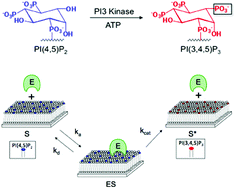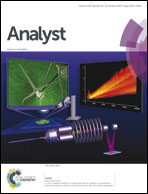PI3 kinase enzymology on fluid lipid bilayers
Abstract
We report the use of fluid lipid bilayer membrane as a model platform to study the influence of the bilayer microenvironment and composition on the enzymology in membrane. As a model system we determined the enzyme kinetics on membranes for the transformation of bilayers containing phosphoinositol(4,5)-bisphosphate (PI(4,5)P2) to phosphoinositol(3,4,5)-trisphosphate (PI(3,4,5)P3) by the enzyme phosphoinositol-3-kinase (PI3K) using radiolabeled ATP. The activity of the enzyme was monitored as a function of the radioactivity incorporated within the bilayer. The transformation of PI(4,5)P2 to PI(3,4,5)P3 was determined using a mass strip assay. The fluidity of the bilayer was confirmed by Fluorescence Recovery After Photobleaching (FRAP) experiments. Kinetic simulations were performed based on Langmuir adsorption and Michaelis–Menton kinetics equations to generate the rate constants for the enzymatic reaction. The effect of cholesterol on the enzyme kinetics was studied by doping the bilayer with 1% cholesterol. This leads to significant reduction in reaction rate due to change in membrane microenvironment. This strategy provides a method to study the enzymology of various kinases and phosphatases occurring at the membrane and also how these reactions are affected by the membrane composition and surface microenvironment.


 Please wait while we load your content...
Please wait while we load your content...